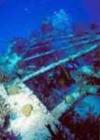
|
The Wreck of the North Carolina
 Bermuda, Bermuda Bermuda, Bermuda
|
Max Depth: 41-50ft/12-15m
Average Viz: 31-35ft/9-11m
Entry Type: Boat
Bottom Composition: Sand
Aquatic Life: Big Animals
|
Summer: 81-85°F/27-29°C
Winter: 61-65°F/16-18°C
|
|

|
|
The Wreck of the North Carolina is a boat accessible salt water dive site, located in Bermuda, Bermuda. The maximum depth is 41-50ft/12-15m. The average visibility is 31-35ft/9-11m.
1880 - English Iron Barque
The wreck of the North Carolina is the classic version of a sunken sailing ship. The vessel was an iron hulled English Barque that measured 205 feet in length and displaced 533 tons. The ill-fated ship sank on New Year’s Day 1880, when she struck the reef. Attempts were made to pull her of the reef, unfortunately there was an accident, the anchor was allowed to drop through the decks, putting a hole in her keel causing her to sink quickly. She was en-route from Bermuda to England with a general cargo of cotton, bark and fuel. Today, The North Carolina sits upright at depths ranging from 25 to 40 feet. The bow and stern are fairly intact while her midsection has collapsed.
She is inside the reef line, which means that there is limited exposure to the larger seas that most of Bermuda’s wrecks fall foul. A exceptionally beautiful bowsprit points toward the surface and neat rows of "dead eyes" attached to steel rigging traces her railings and the curve of her fantail stern adding to the often poor visibility in this area gives the whole wreck a ghostly grace.
Divemasters Notes
North Carolina is a pretty, little wreck, which is best suited for smaller groups of divers. She sits in a bed of sand, where the maximum depth is 45 feet. The sand composition in this area just inside the outer reef line does tend to be extremely silty. Care must be taken to avoid contact with the sand as this will immediately have a dramatic effect upon visibility.
Behind the wreck just off her stern, you can see a grove carved in the reef where she slid down on her way into the sand. The visibility tends to be quite low in this area even without contact with the sand (an average of 30 feet in the summer and 70 feet in the winter).
The rows of "dead eyes", make for excellent photographic subjects as does the splendid heavily encrusted bowsprit pointing towards the surface. Take a brief swim for about 50 feet beyond the bow then turn around and look at the wreck, with the limited visibility, it looks like a ghost ship???
Other points of interest include the crow’s nest, The old-style "heads" or toilets along the bow which were "flushed and wiped" by the ocean water splashing up the bow. The"fantail" stern makes a great hiding place for eels and lobsters. Look closely on either side of the bow, you should be able to make out the lettering that spelt out her name.
This area is great for Hog Fish, some of which can reach gigantic size. There are often Margate, large schools of Snapper and Porgies. On the surrounding reef system, you can usually find lobsters. It is essential that you not venture too far off the wreck. Navigation is difficult especially in the often limited visibility. I can assure you there is precious little to see more than 50 feet away from the wreck. I’ve looked!!! Fortunately it only took the boat about 30 minutes to find me!!
REMEMBER.... THE REEF IS FRAGILE! PLEASE DO NOT TOUCH OR TREAD ON LIVING CORAL.